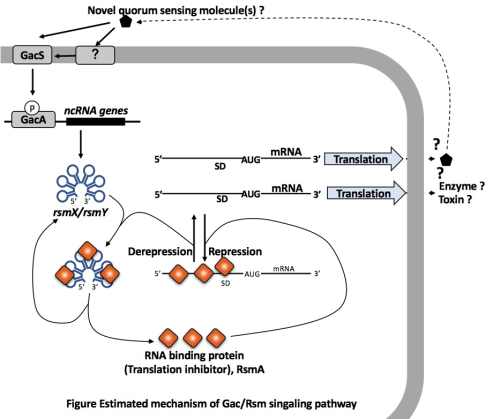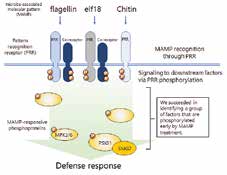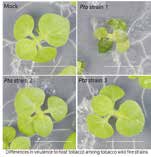Research Area : Genetic Engineering
Regulation of virulence-related gene expression by Gas/Rsm-mediated quorum sensing in plant pathogenic bacteria
Understanding the mechanisms by which phytopathogens express their virulence is crucial for controlling plant diseases. Using Gram-negative phytopathogen Pseudomonas syringae pv. tabaci 6605 as a model pathogen, we have investigated important virulence factors using a large variety of virulence-related mutant strains such as ∆fliC, a defective mutant of flagellar filament protein, ∆psyI, a defective mutant of acyl-homoserine lactones (AHL) synthetase in quorum sensing system and so on. We recently found that many isolates including P. syringae pv. tomato DC3000 (PtoDC3000), do not produce AHL. In these strains, the open reading frames of psyI, which encodes an AHL synthase, or psyR, which encodes the transcription factor PsyR were mutated. These results indicate that many isolates of P. syringae have genetically lost AHL production ability by the mutation of their responsible genes. To examine whether PtoDC3000 modulates the gene expression profile in a population-dependent manner, we carried out microarray analysis using RNAs prepared from low- and high-density cells. And then, we found that the expression of the small noncoding RNAs rsmX and rsmY were remarkably activated in high-density cells, but abolished in a ∆gacA mutant of Pta6605. These results indicate that regardless of the ability to produce AHL, P. syringae regulates the expression of rsmX/Y by currently unknown quorum-sensing molecules. We now investigate the function and mechanism of rsmX and rsmY-related regulation of the expression of virulence-related gene expression.

Research Area : Genetic Engineering
Elucidation of the regulatory mechanism of plant immune responses by focusing on MAMP-responsive phosphoproteins

Plants have a defense mechanism to protect themselves from infection by various pathogens. An understanding of the defense mechanisms of plants is essential for efficient plant breeding. Pattern recognition receptors (PRRs) on the cell membrane recognize the basic structure (Microbe-associated molecular pattern: MAMP) of the microorganism and exert resistance. Many PRRs contain protein kinase domains and, after MAMP recognition, transmit signals downstream via protein phosphorylation. In other words, if we can elucidate the function of proteins whose phosphorylation changes with MAMP recognition, it will help us to understand the molecular mechanism of disease resistance. We have identified several MAMP-responsive phosphoproteins and are investigating the role of their resistance mechanisms.
Elucidation of the regulatory mechanism of plant immune responses by focusing on MAMP-responsive phosphoproteins

Plant pathogens have evolved various molecular mechanisms to establish infection in the host plant. On the other hand, even plant pathogenic bacteria that can establish infections in plants have different pathogenicity to host plant. The clarification of the molecular mechanisms involved in the exertion of pathogenicity is expected to lead to the development of more efficient drugs and the establishment of infection prevention methods. Currently, we are clarifying the differences in pathogenicity between multiple strains and searching for gene regions important for pathogenicity through comparative genomic analysis.




